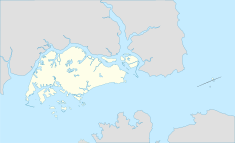Old Thong Chai Medical Institution Contents History Commercial history Architecture References External links Navigation menu1°17′14.3″N 103°50′44″E / 1.287306°N 103.84556°E / 1.287306; 103.84556"Thong Chai 150 – 同济150周年"Singapore eCitizen websiteSingapore Infopedia
National monuments of SingaporeInfrastructure completed in 1892Singapore RiverForever Living Products
ChineseSingaporeEu Tong Sen StreetSingapore River Planning AreaCentral Areacentral business districtChinesecharitymedical centresTraditional Chinese doctorsmedicineracescommercialForever Living ProductstwoChinesemerchantstraditional Chinese medicalcharitable organisationmedicalherbal medicinesreligionCantoneseHokloTeochewHainaneseHakkarentedshophouseUpper Pickering StreetThong Chai Medical InstitutionbusinesspoliticalclanChinese Chamber of CommerceChinaJapanChin Swee Roadnational monumentnightclubrestaurantsTung Lok GroupSARSsouthern ChinesehallsaxiscourtyardsChinese architectureceilingsroofridgefriezesplasterreliefgable
Coordinates: 1°17′14.3″N 103°50′44″E / 1.287306°N 103.84556°E / 1.287306; 103.84556
| Old Thong Chai Medical Institution | |
|---|---|
 Old Thong Chai Medical Institution in 2006 | |
| Location | 50 Eu Tong Sen Street |
| Built | 1892 |
| Governing body | National Heritage Board |
National monument of Singapore | |
| Designated | 6 July 1973 |
 Location of Old Thong Chai Medical Institution in Singapore | |
The Old Thong Chai Medical Institution (Chinese: 旧同济医院) is a historic building in Singapore, and is located at Eu Tong Sen Street in the Singapore River Planning Area, within the Central Area, Singapore's central business district.
The building was constructed in 1892, and housed one of the best known Chinese charity medical centres in Singapore. Traditional Chinese doctors or sinsehs used to dispense free treatment and medicine to patients of all races in Singapore. Today, it is used as a commercial building for the Singapore office for Forever Living Products.
The current Thong Chai Medical Institution was located in Thong Chai Building, 50 Chin Swee Road.[1]
Contents
1 History
2 Commercial history
3 Architecture
4 References
5 External links
History

Today, the Old Thong Chai Medical Institution building is used as a retail shop for a healthcare company which is Forever Living Products.
In 1867, two Chinese merchants got together to set up Singapore's first traditional Chinese medical institution for the poor. These compassionate men saw an urgent need for a charitable organisation that provided medical advice and assistance to those who could not afford to pay for it.
Thong Chai dispensed free medical consultation, treatment and herbal medicines to the poor, regardless of race or religion. Its sincere efforts were appreciated and recognised and more benefactors joined its ranks. They came from all Chinese communities: Cantonese, Hoklo (Hokkien), Teochew, Hainanese and Hakka.
Initially, Thong Chai operated out of a small rented shophouse on Upper Pickering Street, then known as Upper Macao Street. It was then called Tong Chay Ee Say. In 1892, it bought the building at 50 Eu Tong Sen Street, with which it has become most strongly associated, and changed its name to Thong Chai Medical Institution.
From this building, Thong Chai continued to serve the poor and sick but it also became a centre for business and political activities. Several clan associations set up their headquarters there; the Chinese Chamber of Commerce was conceived in this building, and its first office operated there until 1906 when it moved to its own premises. In the early years of the twentieth century, when political tensions between China and Japan rose high, Chinese loyalists held public meetings at Thong Chai to garner support for their motherland.
Thong Chai Medical Institution is now located in a ten-storey building in Chin Swee Road, carrying on the Thong Chai tradition much in the way of its predecessors. They celebrated 150 years of operations in 2017[2].
The Old Thong Chai Medical Institution was gazetted as a national monument on 6 July 1973.
Commercial history
The late 1990s saw the building first becoming a nightclub and later a number of restaurants. In 2000, the building was acquired by Tung Lok Group and the building became a restaurant known as Jing. Not long after its opening, the group revamped its concept and named it Asian. Both restaurants proved to be unpopular, and it closed down in 2003 due to SARS outbreak. The building was unused for around two years and it was converted into its current use in 2005.
The building is currently owned by Forever Living Products Intl, a multi-level marketing company selling aloe vera products. The company bought the building from the government in 2005 for S$7 million. The furnishing and such cost the company an additional $3 million as they imported the antique furnitures from Malaysia and China.
Architecture
The typically southern Chinese building on Eu Tong Sen Street comprises three main halls aligned on a central axis and separated by courtyards and an air well.
In keeping with the social principles of southern Chinese architecture, the importance of the halls in the hierarchy of the building is reflected in the height of their ceilings.
Another atypical feature is the roof. Although the decorative elements on the roof ridge are in the southern Chinese style, the ridge itself is not. Unlike the characteristic curve of a southern Chinese roof ridge, this one is completely straight. Decorating the roof are friezes of Chinese scenery executed in plaster relief work and wave-like gable end walls.
References
^ https://www.stcmi.sg/Public/en/STCMI_P_Contactus.aspx
^ "Thong Chai 150 – 同济150周年". thongchai150.sg. Thong Chai 150th Anniversary Walkathon. Retrieved 27 May 2017..mw-parser-output cite.citationfont-style:inherit.mw-parser-output .citation qquotes:"""""""'""'".mw-parser-output .citation .cs1-lock-free abackground:url("//upload.wikimedia.org/wikipedia/commons/thumb/6/65/Lock-green.svg/9px-Lock-green.svg.png")no-repeat;background-position:right .1em center.mw-parser-output .citation .cs1-lock-limited a,.mw-parser-output .citation .cs1-lock-registration abackground:url("//upload.wikimedia.org/wikipedia/commons/thumb/d/d6/Lock-gray-alt-2.svg/9px-Lock-gray-alt-2.svg.png")no-repeat;background-position:right .1em center.mw-parser-output .citation .cs1-lock-subscription abackground:url("//upload.wikimedia.org/wikipedia/commons/thumb/a/aa/Lock-red-alt-2.svg/9px-Lock-red-alt-2.svg.png")no-repeat;background-position:right .1em center.mw-parser-output .cs1-subscription,.mw-parser-output .cs1-registrationcolor:#555.mw-parser-output .cs1-subscription span,.mw-parser-output .cs1-registration spanborder-bottom:1px dotted;cursor:help.mw-parser-output .cs1-ws-icon abackground:url("//upload.wikimedia.org/wikipedia/commons/thumb/4/4c/Wikisource-logo.svg/12px-Wikisource-logo.svg.png")no-repeat;background-position:right .1em center.mw-parser-output code.cs1-codecolor:inherit;background:inherit;border:inherit;padding:inherit.mw-parser-output .cs1-hidden-errordisplay:none;font-size:100%.mw-parser-output .cs1-visible-errorfont-size:100%.mw-parser-output .cs1-maintdisplay:none;color:#33aa33;margin-left:0.3em.mw-parser-output .cs1-subscription,.mw-parser-output .cs1-registration,.mw-parser-output .cs1-formatfont-size:95%.mw-parser-output .cs1-kern-left,.mw-parser-output .cs1-kern-wl-leftpadding-left:0.2em.mw-parser-output .cs1-kern-right,.mw-parser-output .cs1-kern-wl-rightpadding-right:0.2em
- National Heritage Board (2002), Singapore's 100 Historic Places, Archipelago Press,
ISBN 981-4068-23-3 - Preservation of Monuments Board, Know Our Monuments
| Wikimedia Commons has media related to Old Thong Chai Medical Institution. |
External links
- Singapore eCitizen website
- Singapore Infopedia
